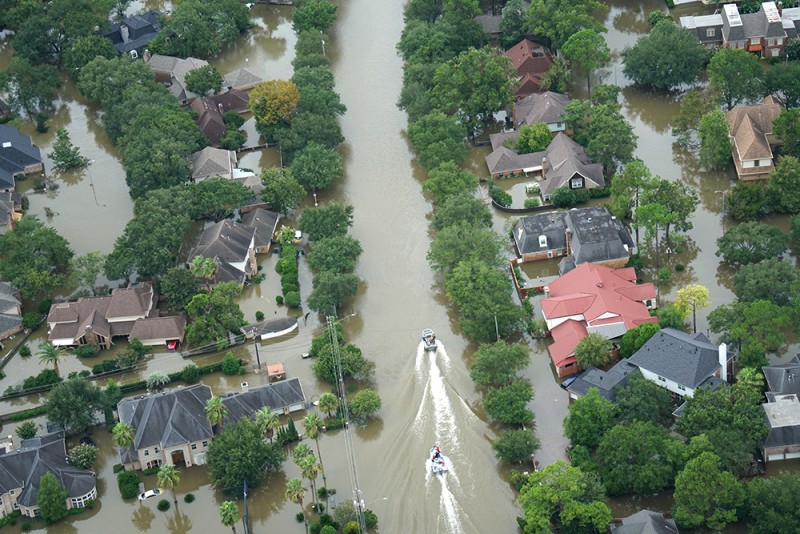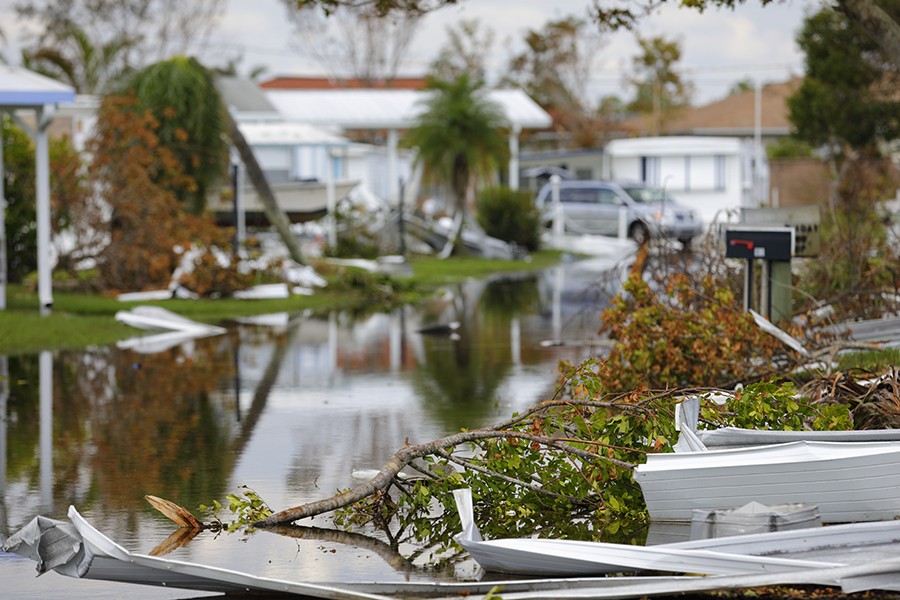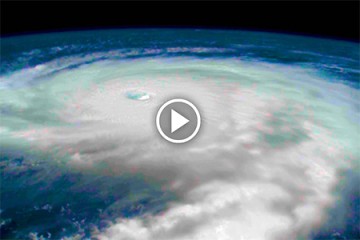In a matter of weeks this summer, Hurricane Harvey swamped Houston with rainfall of Biblical proportions while two other monster storms—Irma and Maria—clobbered the Caribbean islands and the Florida peninsula. The U.S. territory of Puerto Rico was especially hard hit.
The devastation has wrought social, political, and economic turmoil and has left policymakers in the United States to wonder what can be done to better prepare for the next disaster.
Carey Business magazine recently sat down with five experts from the Carey Business School's faculty to explore how we might apply the lessons of business and economics to the threat of natural disasters—disasters that seem likely to increase in number and strength in coming years.
Can you give us some sense of the scope of the problem we are facing in the U.S.?
Luis Quintero, an assistant professor and expert in the economic metrics of urban growth and housing markets: From a strictly numbers basis, the economic figures are compelling. You have 50 percent of the population and 57 percent of the national income coming from the risky coastal areas. This is where the majority of our economy and our people are located, although it only makes up 13 percent of the continental U.S. area. It's very costly to move, and people want to live near the water. They are not internalizing the risk of their location.
Lindsay Thompson, an associate professor specializing in the role of character and human values in business, society, and corporate culture: In the last five years, three of our five biggest cities have been hit by huge natural disasters—Harvey in Houston, and Sandy in Philadelphia and New York. We're all threatened by these storms.
And so, there are two big political challenges: First, Americans don't like to pay for public goods—shared goods and services like roads, public education, and environmental protection. One example I can point to is right here in Maryland: Gov. Larry Hogan's election campaign appeal to voters against the so-called "rain tax"—a term that ridiculed and trivialized the Maryland General Assembly's solution to environmental protection measures designed to reduce the footprint of impermeable surfaces that contribute to toxic runoff into the Chesapeake Bay.
And, second, we love freedom of choice. But what happens when individual choice comes at the expense of the public good? Those free individuals become free riders. And how fair is that to the people who do buy flood insurance, to the people who choose to be prepared?
James Calvin, professor and an authority on leadership and community economic development: Internationally and domestically, a lot of global public policy is focused on cities. The push really has been for some decades now to create very dense population areas. And we're learning that greater density just isn't sustainable sometimes. But even the less dense areas are in a bind. Think of the Florida Keys where they had trailer parks built on sandbars. The question now becomes not "Will the area be rebuilt?" but "Should it be rebuilt?"
Chester Chambers, an assistant professor and the academic program manager of the risk management programs at Carey and a former flood plain analyst for the Army Corps of Engineers and the Federal Emergency Management Agency: From a preparation perspective, Hurricane Katrina was the most anticipated natural disaster in human history. Where did it get us? The city had hurricane drills every year for 50 years; and it all worked great, until they got punched in the mouth.
The big problem, from a business perspective, is that the economic incentives are not properly aligned with flood insurance rules. Even when one convinces the local government to agree with a flood insurance program, they will often issue variances. A city always has an incentive to count everything as a special circumstance. Their top priorities are jobs and property taxes, not disaster preparedness.
Then there is the moral hazard problem. People will buy a house on the beach because they like houses on the beach. And when it blows away, they know insurance is going to pay to replace it. So, insurance artificially inflates the value of those properties. People are rewarded for owning property in these areas.
Paul Ferraro, a Bloomberg Distinguished Professor and expert in the use of behavioral economics to design environmental policy: None of this is new. If you go back to the 1980s, you'll find the same kind of op-eds asking the same questions: Why are we still developing on flood plains? The fact that we're still writing about this decades later shows how difficult a social problem this is to solve.
Look at it this way: One single county—Harris County, where Houston is located—is the fourth-largest recipient of flood insurance payments in the country. Yet only one in 10 residents of Harris County has flood insurance. It's not like we don't know it is going to flood. It gets hammered repeatedly. Fifty inches of rain, that may be new; flooding and damage and huge payouts, that is not new in Harris County. The National Wildlife Federation did a study that found flooded homes were bailed out and rebuilt multiple times. In one case, the federal government had spent over a million dollars on a home worth $125,000. That's not sustainable.

Image caption: Floodwaters inundate a Houston-area neighborhood in the aftermath of Hurricane Harvey.
Image credit: Karl Spencer / Getty Images
If you had one recommendation for all those municipal officials and risk managers out there, what would it be?
Calvin: If I were city manager in Houston or another disaster-prone city, I would have a community development task force beginning to talk seriously about these things. This applies to all disasters, not just hurricanes and floods—fires, earthquakes, tornadoes, drought. No part of the country is immune. Solving these problems requires greater community engagement by average, everyday citizens. I also think zoning needs to be a big focus for cities. Houston is going to have to look long and hard at the effects of its poor zoning, and others will have to learn from those lessons.
Chambers: In the aftermath of a disaster like Katrina or Harvey, if one talks to some business leaders about what they're doing in terms of emergency preparedness, the first thing they say is, "We bought insurance." That's great, but purchasing insurance is a tactic, it's not a disaster-preparedness strategy. I don't believe you can solve these problems at a local level. It's going to require local, state, and federal cooperation. There has to be a larger regional plan with federal oversight and funding to make it work.
Quintero: These are tough choices that must be done proactively, not in retrospect. If you get the flu, you go get some medication to treat it, but you have not prevented the flu. To do that, you needed the flu shot. In this case, the flu shot is letting the market price-in risk—the greater risk, the more you pay.
Basic economic theory tells you: Don't provide federally subsidized flood insurance for people who live in risky places. When you do, you are incentivizing people to live in places that have nice views and a lot of risk. This is, however, very tough to do politically, and also in terms of basic human rights, once the disaster has happened, so it has to be done gradually. Investment in infrastructure is another way to alleviate the effects, but again, that will only partially prevent the effects of a disaster.
Thompson: We need long-term thinking. FEMA says that one dollar of mitigation saves four in recovery cost, but no one listens to that. We need to have better land-use and building standards. We need to have ecosystem protection. We need to have permeable surfaces for all our built environments. We need to say, "You know, maybe we shouldn't build hard surfaces on wetlands."
Almost all of Houston is on a wetland. Houston paved over so much of their surface and there was no place for the water to go. We have the same issue in Baltimore; we've built over natural wetlands around the harbor. We've made a joke of permeable surfaces by labeling a state-mandated stormwater management fee a "rain tax." The good news is that, over time, when you have these conversations again and again, it does change public will. But you have to be relentless. People don't change their perceptions with one conversation.
Ferraro: When you skimp on investments—and for years, we've skimped on infrastructure, sewers, roads, and bridges—it becomes an incredibly expensive problem to reverse or mitigate. Coming from economics, my feeling is it's all about incentives. The citizens don't have an incentive because being prepared raises their housing prices. And, until local governments have incentives to change how they develop, we're not going to see any change.
Let's anticipate these disasters and use building codes to limit where people can build. It may sound extreme, but deny federal or state infrastructure funds to cities that develop in flood zones. Tell people that if you develop there, you bear the costs. That's the ultimate incentive, but it is politically difficult to deliver. When there is a flood, the last thing anybody wants to see or hear is finger-wagging and talk of making it harder to rebuild. So no one gets rewarded for doing the right thing. The solutions are not aligned with incentives.
Can you point to some places where you think leaders have done a good job?
Calvin: In New Orleans, it's better now. Structures have to meet stricter codes, especially in the Lower Ninth Ward where the floods hit so hard. That has led to less rebuilding and reduced the population. Today, post-Katrina New Orleans looks very different than pre-Katrina New Orleans.
Chambers: The most commonly cited examples are Miami and California. They've changed their building codes based on disasters such as Hurricane Andrew and the Loma Prieta earthquake. They've changed their insurance requirements, improved the way they calculate property taxes to ensure disaster-proofing, and altered transportation planning to make evacuations easier.
In New Orleans, they have taken steps such as building houses up on stilts, but the most successful action has been what we call price discrimination: One prices things to create incentives to encourage people to do what one wants them to do. If one wants lower population density in flood plains, then one makes building code changes.
Also see
Thompson: I would say there's no city in the country that really is a model of responsible preparedness. New York, New Orleans, and the Florida coastal cities are somewhat better because they have had disasters, but Houston has been terrible. Look at the Florida Keys; they got a direct hit and they lost 25 percent of their built structures and they think it wasn't so bad. But the only reason for that is the new building codes since Hurricane Andrew. We know how to do things more safely, but we don't want to pay for it.
Ferraro: Miami has done some things, and Tampa, too, but they're still inadequate. There has been some progress on building less in flood zones, but it's not clear whether that has to do with changes in public policy or with simply running out of flood-prone land to build on.
I will say New Orleans has changed. A lot of their exposure to risk has been reduced, partly because entire areas of the city were badly damaged and people moved away. But it's hard to tease out how much of that is foresight and how much is exigency.
Quintero: The reaction to the recent hurricane in Miami and Houston, compared to Katrina, for example, shows that information systems have been improved overall. New Orleans has also implemented changes in their construction codes to reduce risk for future events.
Should climate change factor into our decision making?
Quintero: Definitely. Climate change is where the government has not done a very good job. The scientific community agrees that most of these extreme weather events are connected to climate change. These storms will become stronger and more frequent, according to just about every prediction. We need to address the problem. Anything else is a Band-Aid on a bigger problem, a finger in a dam that's about to explode.
Climate change is politically challenging. If you wanted to create a social problem that was hard to solve, it would be difficult to design one as bad as climate change, but acknowledging it is a priority should be the first step.
Calvin: I'm going to say it, I haven't said it up to now, but things do seem to be changing in the environment: Climate change is real. And if that is so, if we look at cities like Norfolk, New York City, and here in Baltimore, if people develop around or close to water, there are going to be big problems in these places. We have to prepare for that reality.
Ferraro: Our leaders in government must face the science of climate change, and extreme weather is only going to become more common and more powerful. Denial of climate change prevents people from recognizing the risks and from taking steps to adapt. We have to look at it as a risk-management challenge.
Thompson: Politicians can argue whether global warming has anything to do with these disasters, but people who know the science do not argue it. And if we have any hope of controlling carbon footprints, the place to start is in cities. That's where we can have the greatest impact.
Chambers: Our decision-makers have certain information and assumptions about the probability of a bad event happening and how the damages from that event might be distributed geographically. As a decision-maker, how does one use that knowledge?
For example, if global warming is real, it becomes wise for various organizations—business, governmental, and nonprofit—that have never had to think about the risks in the past to put plans in place. On the other hand, even if one doesn't believe in global warming, there is still value in preparedness and in addressing vulnerabilities that should be addressed regardless of where one stands on climate change. Are your communications systems reliable? Is your insurance portfolio appropriate? Do your location choices account for acts of nature?
Careful consideration of the risks is always beneficial, even if disaster never occurs. It's just the intelligent thing to do.
Posted in Voices+Opinion, Politics+Society
Tagged economics, disaster response, natural disasters, hurricanes










